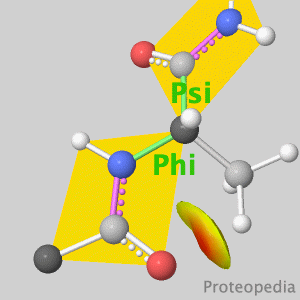Proteopedia:Featured EDU/1
From Proteopedia
(Difference between revisions)
| (5 intermediate revisions not shown.) | |||
| Line 1: | Line 1: | ||
<table> | <table> | ||
| - | <tr><td> | + | <tr><td> |
| + | <imagemap> | ||
| + | Image:Featured-ramachandran.gif|center | ||
| + | default [[Tutorial:Ramachandran_principle_and_phi_psi_angles]] | ||
| + | </imagemap> | ||
| + | </td></tr> | ||
<tr><td><div class="scrolling">'''Tutorial: The Ramachandran principle, phi (φ) and psi (ψ) angles in proteins'''<br> | <tr><td><div class="scrolling">'''Tutorial: The Ramachandran principle, phi (φ) and psi (ψ) angles in proteins'''<br> | ||
''by Eric Martz''<br> | ''by Eric Martz''<br> | ||
The Ramachandran Principle says that alpha helices, beta strands, and turns are the most likely conformations for a polypeptide chain to adopt, because most other conformations are impossible due to steric collisions between atoms. | The Ramachandran Principle says that alpha helices, beta strands, and turns are the most likely conformations for a polypeptide chain to adopt, because most other conformations are impossible due to steric collisions between atoms. | ||
Check Show Clashes to see where non-bonded atoms are overlapping, and thus in physically impossible positions. | Check Show Clashes to see where non-bonded atoms are overlapping, and thus in physically impossible positions. | ||
| + | |||
| + | >>> [[Tutorial:Ramachandran_principle_and_phi_psi_angles|Visit this tutorial]] >>> | ||
</div> | </div> | ||
</td></tr> | </td></tr> | ||
Current revision
Tutorial: The Ramachandran principle, phi (φ) and psi (ψ) angles in proteins
by Eric Martz >>> Visit this tutorial >>> |


